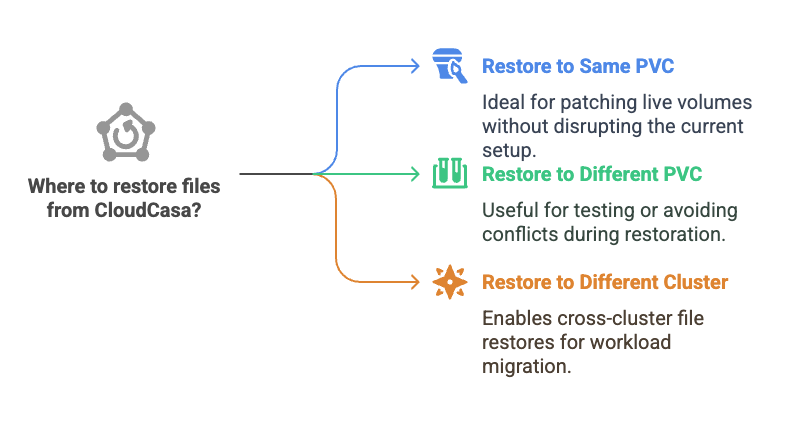Ready to see file-level restore in action? Try it yourself with CloudCasa today.
Kubernetes environments move fast — and when something breaks, it can break fast. If you’re a platform engineer managing stateful apps or a DevOps lead keeping critical workloads alive, you’ve likely felt the sting of a storage misstep. One wrong file deletion or a corrupted directory, and suddenly you’re restoring entire volumes just to recover a few megabytes. That’s where file-level restore comes in — the smarter way to recover only what you need, without the overkill. It’s like rebooting a whole datacenter because someone unplugged a single server — unnecessary and painful.
CloudCasa, the Kubernetes backup service from Catalogic, is stepping into that chaos with something deceptively simple but game-changing: file-level restore. It’s the kind of feature that sounds boring on a slide deck — until you need it. Then it’s your new best friend.
The Old Way: Mount, Browse, Extract, Sigh
Before this update, restoring a file from a Kubernetes volume backup usually meant restoring the whole PVC, and then jumping through some hoops: perform the restore, spin up a pod, SSH into it, fish around for what you need, and hope you don’t mess something else up along the way. It’s not just tedious — it’s risky, and it takes time you probably don’t have.
Now CloudCasa handles it all for yous — no volume restores, manual pod creation, shelling in, or fiddling with mounts. The process is built into the restore flow, neatly integrated into the CloudCasa UI. You click a backup, explore the file tree inside it, check off the files or folders you want, and choose where to send them.
That’s it.
How It Works: File Picker Meets Cross-Cluster Freedom
Here’s the rundown: when you’re restoring a cluster in CloudCasa, you’ll now see a “Files” tab during the Select Resources step. Clicking “Select Files” lets you open a browser-style view of the backup contents — like digging into a ZIP file, but Kubernetes-native.
You can pick individual files, full folders, or even a whole directory structure. Once you’ve selected your target, you get to choose where it lands:
- Restore to the same PVC — for when you’re patching up a live volume.
- Restore to a different PVC — helpful when testing or trying to avoid conflicts.
- Restore to a PVC in a different cluster — CloudCasa supports cross-cluster file restores when the destination cluster is accessible and configured in the same CloudCasa account.
This kind of flexibility is a big deal. Whether you’re migrating workloads between clusters or just need to pull a config file from last Tuesday’s backup, you’re not stuck with all-or-nothing decisions.
Where This Shines: Granularity File Level Restore, Speed, and Sanity
CloudCasa’s new file-level restore isn’t just about convenience — it marks a shift in how teams approach data recovery in containerized environments. Traditional backup tools treat data like a single monolithic block: if something goes wrong, you’re forced to restore the entire thing, even if you only need one file. That approach might’ve worked in static, legacy environments. But in Kubernetes, where everything is dynamic and modular, you need surgical precision — not a sledgehammer.
This feature delivers that. It’s tailored for the real-life “oh no” moments, like restoring a misconfigured app with minimal interruption. It’s also perfect for security and compliance scenarios where you need to extract specific files from historical backups
The UI: Clean, Clickable, and Actually Useful
The user interface here deserves some praise. The file browser is exactly what you want it to be — responsive, intuitive, and not trying to reinvent the wheel. Navigating the file system inside a PVC backup feels natural, and the restore wizard gives you clear guidance. .
Compared to the Rest: CloudCasa Keeps It Clean
File-level restore isn’t new as a concept — enterprise backup platforms have had versions of it for years. But few bring it to Kubernetes with this level of polish and practicality. Other tools often require mounting snapshots, using external file explorers, or relying heavily on CLI workarounds. CloudCasa puts it all in one place, in a way that feels designed for developers, not just backup admins.
Combine that with CloudCasa’s existing strengths — agentless backups, cross-cluster recovery, native Kubernetes support — and it becomes clear this isn’t just a nice-to-have. It’s a core feature for modern cloud-native operations.
Final Thoughts: A Small Feature with Big Impact
In Kubernetes, simplicity is often the hardest thing to achieve. Everything is dynamic, abstracted, and maybe a little bit chaotic. File-level restore in CloudCasa is one of those rare features that cuts through the noise. It’s not flashy, but it’s a huge quality-of-life upgrade for anyone managing real workloads in production.
Being able to restore exactly what you need — without overthinking, overprovisioning, or over-restoring — brings peace of mind. And in the fast-moving, sometimes-on-fire world of DevOps, that’s priceless.
So no, it’s not the most exciting feature on the spec sheet. But next time someone nukes a directory they shouldn’t have touched, you’ll be glad it’s there.
